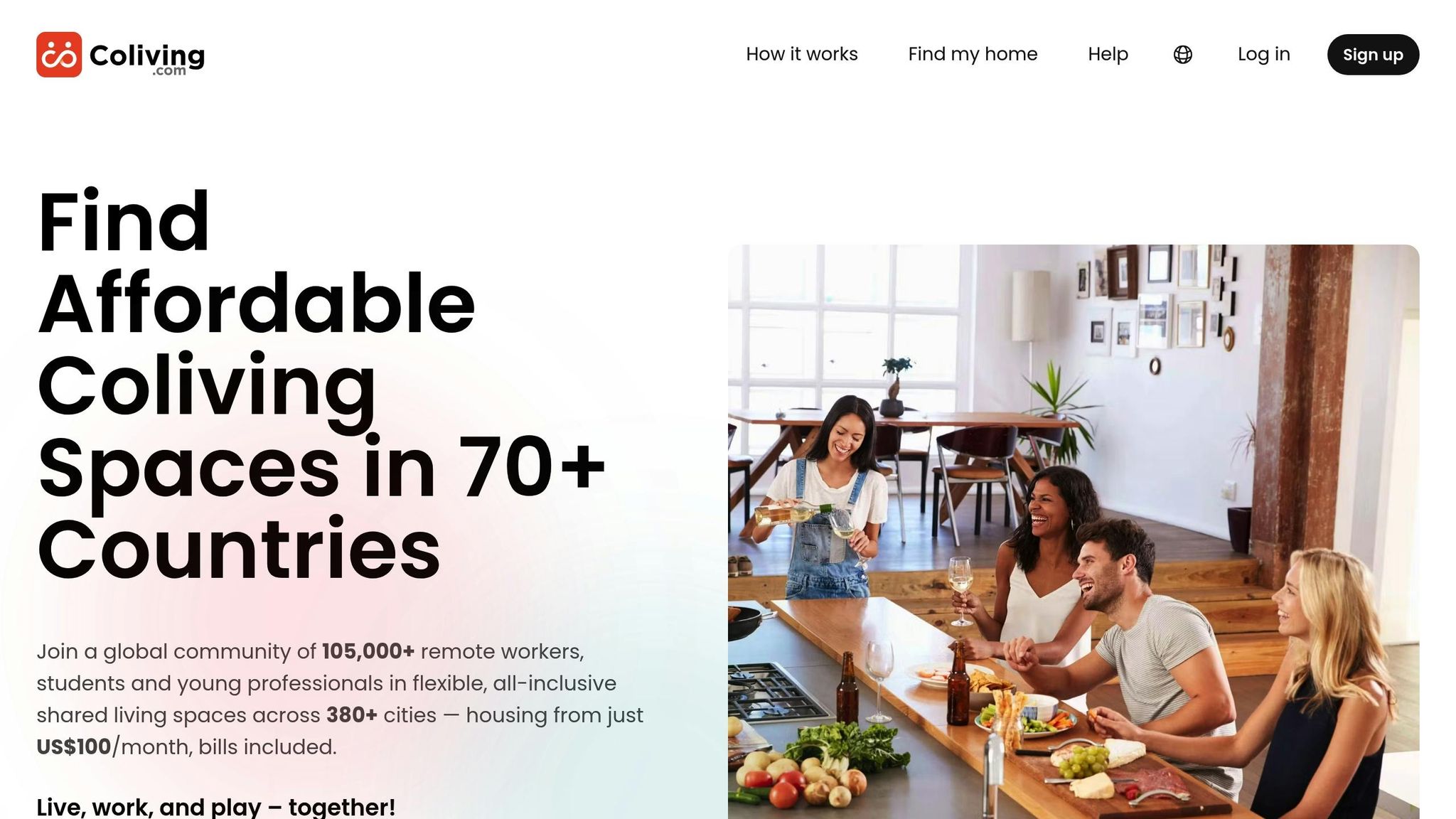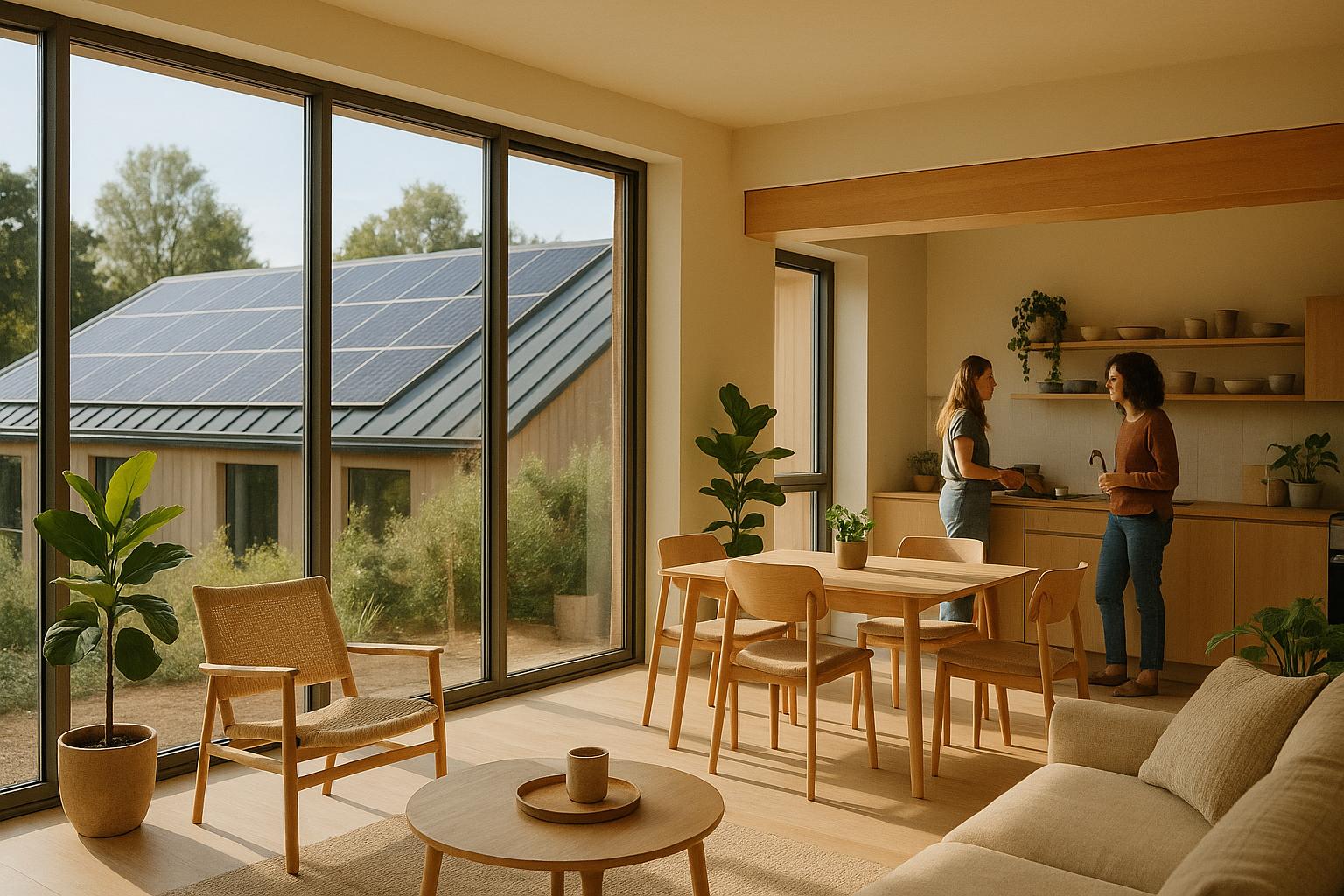Seasonal coliving in 2025 is reshaping how people live and work, offering flexibility to move between locations based on weather, lifestyle, or activities. It combines shared living spaces with all-inclusive services like utilities, Wi-Fi, and cleaning, making it an appealing choice for remote workers, digital nomads, and young professionals.
Key Takeaways:
- What It Is: A housing option allowing people to live in different locations seasonally, with fully furnished spaces and built-in communities.
- Why It’s Popular: Cost-effective (up to 40% cheaper than traditional rentals), fosters social connections, and supports eco-conscious living.
- Top Destinations for 2025:
- Winter: Chiang Mai, Thailand; Taghazout, Morocco
- Spring: Sines, Portugal; Albanian Coast
- Summer: Jávea, Spain; Cape Town, South Africa
- Fall: Briançon, France; Mexico City, Mexico
- Costs: Monthly rates range from $300 (basic) to $3,000 (luxury), with savings on furniture, utilities, and maintenance.
- Platforms: Tools like Coliving.com simplify finding and booking spaces, with verified reviews and flexible terms.
Seasonal coliving is more than housing - it's a lifestyle that blends affordability, community, and freedom to explore global destinations year-round.
Best Seasonal Coliving Destinations for 2025
If you're considering a flexible lifestyle with shared living spaces, 2025 offers some incredible seasonal coliving destinations. Whether you're chasing warmer climates, scenic landscapes, or vibrant communities, there's something for everyone.
Top Destinations by Season
Winter Escapes (December – February)
- Chiang Mai, Thailand: Known for its dry season and comfortable weather, Chiang Mai is a favorite for remote workers. Alt Coliving Chiang Mai stands out with its central location, strong sense of community, and fully equipped coworking spaces - perfect for digital nomads, startups, and entrepreneurs.
- Taghazout, Morocco: This laid-back surf village is home to SunDesk, which offers a unique balance of work and leisure on Morocco's stunning Atlantic coast.
Spring Adventures (March – May)
- Sines, Portugal: Nestled along Portugal's coastline, Manas Coliving - founded by sisters Inês and Rita - provides a space for creativity, connection, and relaxation.
- Albanian Coast: With beachfront coliving options starting at under $300 per month, the Albanian Coast offers Mediterranean vibes without the hefty price tag.
Summer Hotspots (June – August)
- Jávea, Spain: This Spanish coastal town boasts a thriving coliving scene. Sun and Co. Coliving, established in 2015, has gained recognition for its welcoming community and ideal mix of work and leisure.
- Cape Town, South Africa: A magnet for digital nomads, Cape Town combines adventure with practicality. With reliable fiber internet and the option of a 3-year nomad visa, it's an excellent summer pick.
Fall Retreats (September – November)
- Briançon, France: Located in the French Alps, Briançon offers a serene alpine setting with a touch of history. Cloud Citadel provides a peaceful environment for focused work.
- Mexico City, Mexico: This bustling city has become a favorite for expats, thanks to its vibrant culture, modern amenities, and growing digital nomad community.
Key Factors to Consider When Choosing a Destination
When picking a coliving spot, it's essential to weigh factors like climate, cost, and infrastructure to ensure an enjoyable and productive stay.
Climate and Comfort
Weather can make or break your experience. For instance, Chiang Mai's dry season provides consistent comfort, while Mediterranean destinations like Portugal may get quite hot during summer.
Budget and Living Costs
Coliving can save renters up to 30% compared to traditional housing, according to the Coliving Report 2025. Costs vary widely:
- In Southeast Asia, Ho Chi Minh City offers coliving for about $1,048 per month, with low daily expenses.
- European cities like Lisbon average around $1,630 monthly.
- The Balkans, including Budva (Montenegro) and Plovdiv (Bulgaria), offer affordable furnished apartments and coliving options.
Infrastructure and Connectivity
Reliable internet is a must for remote workers. Cities like Budapest and Lisbon deliver high-speed connections (170–175 Mbps), while Canggu, Bali, may have slower speeds (20–50 Mbps), which could be challenging for video calls or streaming.
Visa Options
Long-term visas can simplify your stay. Thailand's 5-year DTV visa makes Chiang Mai particularly appealing, while Hungary’s 2-year White Card is a great option for those heading to Budapest.
Safety and Neighborhood Quality
Look for secure accommodations with features like CCTV and proximity to essentials like supermarkets, coffee shops, and parks. Noise levels and overall neighborhood vibe should also factor into your decision.
Comparison Table of Destinations
| Destination | Best Season | Monthly Cost (USD) | Internet | Key Highlights |
|---|---|---|---|---|
| Chiang Mai, Thailand | Winter | $1,107 | Reliable fiber | 5-year visa, strong community |
| Taghazout, Morocco | Winter | N/A | N/A | Surf culture, Atlantic coast |
| Sines, Portugal | Spring | N/A | N/A | Coastal charm, creative hub |
| Albanian Coast | Spring | Under $300 | N/A | Beachfront, budget-friendly |
| Jávea, Spain | Summer | N/A | N/A | Award-winning community |
| Cape Town, South Africa | Summer | $1,500–2,500 | Reliable fiber | 3-year nomad visa |
| Briançon, France | Fall | N/A | N/A | Alpine setting, historic charm |
| Mexico City, Mexico | Fall | $1,500–2,000 | 60+ Mbps | Vibrant culture, expat scene |
Southeast Asia and the Balkans often offer excellent value for money, while European destinations lean toward premium experiences. Emerging markets like Mexico City strike a balance between affordability and modern conveniences.
Budgeting and Cost-Saving Strategies
Managing your budget effectively is essential for making the most out of seasonal coliving without breaking the bank. For many U.S.-based travelers, seasonal coliving can actually be a more wallet-friendly option compared to traditional housing, especially when you consider the hidden expenses that often come with standard rentals.
Breaking Down Monthly Expenses
When evaluating the costs of seasonal coliving, it’s important to look beyond just the rent. Traditional rentals often come with extra expenses - utilities, internet, furniture, and maintenance - that can quickly add up. In major U.S. cities, the savings can be impressive. For instance, while a studio apartment in New York City averages around $3,500 a month, coliving spaces typically cost about $1,799. That $1,700 difference can go a long way in covering other living costs.
For those considering international coliving options, here’s a general breakdown of monthly prices:
- Basic options: $300–$600
- Mid-range spaces: $600–$1,200
- Premium locations: $1,200–$1,800
- Luxury experiences: $1,800–$3,000
What sets coliving apart is what’s included. Unlike traditional rentals, where you’re responsible for setting up and paying for utilities, internet, and furniture, coliving spaces bundle these into one predictable payment. This bundled approach simplifies budgeting and often results in better overall value.
The Value of All-Inclusive Coliving Spaces
"It's an all-inclusive rent. You have your utilities and Wi-Fi included. Even shared goods like paper towels and laundry detergent is provided."
– Amalia Paliobeis, managing director of real estate for Common
Here’s a side-by-side comparison of traditional rentals versus coliving arrangements:
| Expense Category | Traditional Rental | Coliving |
|---|---|---|
| Base Rent | Paid separately | Included in one payment |
| Utilities | Individually billed | Included |
| Internet/Wi-Fi | Additional monthly cost | Included |
| Streaming Services | Separate subscription cost | Often included |
| Cleaning Services | Extra cost for professional cleaning | Included |
| Furniture | Requires upfront investment | Fully furnished |
| Kitchen Essentials | Purchased separately | Provided |
Traditional rentals can also have hefty upfront costs, especially for shorter stays. For example, setting up furniture might cost $3,300–$4,000, internet installation fees can be around $100 with ongoing monthly charges of $50, and security deposits often equal two to three months’ rent. In contrast, most coliving spaces require only a one-month deposit and already include furniture and other essentials.
The savings are particularly noticeable in high-cost areas. Near the University of Southern California, coliving options range from $1,000 to $1,500, while one-bedroom apartments average $2,500. Similarly, in neighborhoods near the University of Washington, coliving rents are typically 25–35% lower than traditional apartments.
"The emergence of co-living communities over the last few years has largely been a response to rising housing costs and the need for more affordable housing options - especially in major U.S. markets."
– CBRE and Streetsense (2019 study)
Tips for Finding Affordable Options
Finding a budget-friendly coliving space requires a bit of strategy and flexibility. Compare total monthly costs carefully - a $600 rental that requires you to pay for utilities and internet may end up costing more than an $800 coliving space where everything is included.
Platforms like Coliving.com can be a great resource. They list options across 70+ countries, with prices starting as low as $100 per month (converted to local currency). Many of these budget-friendly spaces are in emerging markets or involve shared-room setups.
Timing also plays a big role in saving money. Booking two to three months in advance can often secure early bird discounts, and seasonal pricing can work in your favor. Flexible lease terms, like month-to-month arrangements, are another advantage of coliving, letting you avoid long-term commitments.
For even more savings, consider destinations where your money stretches further. While popular cities like Barcelona and Lisbon are well-known, places like Plovdiv, Bulgaria, or Ho Chi Minh City, Vietnam offer modern amenities at a fraction of the cost. Referral programs are another way to cut costs - many coliving spaces offer credits or discounts when current residents refer new members.
When you add up the convenience of bundled bills, the time saved on managing separate expenses, and the networking opportunities that come with coliving, even premium options often prove to be more cost-effective than traditional rentals. It’s a smart, hassle-free way to plan your seasonal living experience.
Planning for Each Season
Once you've chosen your destination and set your budget, the next step is planning for each season. This means preparing for shifts in weather, local events, and travel logistics. A good plan also includes packing smartly for different climates.
Seasonal Packing Tips
Packing for coliving across seasons means being ready for various climates and local customs. The key? Versatility and knowing what your coliving space already provides.
"Packing for transitional weather is all about versatility." - Priyanka Swamy, Founder of Perfect Locks LLC
Climate-Specific Essentials
For colder climates, layering is your best friend. Bring thermal base layers, insulating mid-layers, and waterproof outerwear. Accessories like insulated gloves, wool scarves, hats, and thick socks are must-haves. If you're heading somewhere snowy, snow pants and waterproof boots are essential. To save luggage space, wear your bulkiest items while traveling.
"Choose breathable and insulating fabrics, like cotton and merino wool." - Priyanka Swamy, Founder of Perfect Locks LLC
For warmer destinations, focus on breathable fabrics and sun protection. Pack lightweight shorts, t-shirts, sandals, and swimsuits. Add a wide-brimmed hat, high-SPF sunscreen, sunglasses, and a light cover-up for cooler indoor spaces.
Transitional seasons call for strategic layering. Think lightweight sweaters, versatile jackets, and pants that can handle fluctuating temperatures. A compact umbrella or packable raincoat is also handy for unpredictable weather.
Smart Packing Techniques
- Roll your clothes instead of folding them to save space and minimize wrinkles.
- Use packing cubes to keep items organized and easy to access.
- Create a "day-one essentials" bag with a fresh outfit, toiletries, phone charger, medications, and snacks in case of luggage delays.
When it comes to footwear, stick to versatile options: comfortable walking shoes, a dressier pair, and weather-specific shoes like boots or sandals. This keeps your luggage manageable while covering most situations.
Adapting to Local Weather and Events
Packing is just the start. Understanding local weather patterns and events helps you make the most of your coliving experience. It also ensures you're prepared for the rhythms of daily life in your destination.
Weather Pattern Research
Before you book your trip, dive into historical weather data. Look beyond the current forecast to identify trends like monsoon seasons, hurricane periods, or extreme temperature shifts. Daylight hours are another factor - Northern European cities might have as little as 6–7 hours of daylight in winter, while equatorial regions enjoy consistent 12-hour days. These details can affect everything from your energy levels to local business hours.
Cultural Events and Seasonal Celebrations
Seasonal events are a great way to connect with your new community. From autumn harvest festivals to summer music events and winter holiday markets, these gatherings offer a glimpse into local life. For instance, in 2022, Sun and Co. hosted an American coliver who returned with five friends after experiencing the area's local festivities the previous year. Engaging in these moments can lead to meaningful connections.
Practical Adaptation Strategies
Tailor your daily routines to the local climate. In hot areas, locals might take breaks during the hottest part of the day and stay active in the evening. In cooler regions, mornings might start later to align with daylight. Adjust your health habits too - sunny destinations call for sunscreen and hydration, while darker places might require vitamin D supplements or light therapy.
For home comfort, adapt to the climate. In warmer areas, use fans, keep curtains closed during peak heat, and enjoy cooler evening breezes. In colder regions, stock up on blankets, warm slippers, and learn how to use the heating system effectively.
Visa and Travel Logistics
Sorting out visas and travel logistics is just as important as packing. Knowing the requirements ahead of time prevents last-minute stress and ensures smooth transitions between destinations.
Understanding Visa Requirements
Check visa requirements through official sources like the U.S. Department of State or Timatic. For example, nationals from 42 countries can enter the U.S. under the Visa Waiver Program (VWP). If you're eligible, apply for travel authorization through the Electronic System for Travel Authorization (ESTA) at least 72 hours before departure. ESTA approvals are valid for up to two years or until your passport expires.
For countries requiring traditional visas, start the process 2–3 months in advance, as timelines can vary. Make sure your passport is valid for at least six months beyond your stay. Keep both digital and physical copies of important documents like your passport, visas, ESTA approval, travel insurance, and emergency contacts. If you have a valid U.S. visa in an expired passport, it remains effective when presented with a new, valid passport.
Travel Timeline Planning
Plan for travel time between destinations, including potential layovers or delays. Giving yourself extra time can make transitions smoother.
"Using Sherpa via Delta FlyReady – a fast, convenient and more personalized view of travel requirements for customers traveling internationally – is optional and customers can, as always, obtain visas or complete other entry documentation directly with the relevant international government agencies, independently." - Delta Air Lines Spokesperson
Be aware of visa validity periods. Tourist visas often allow stays of 30–90 days, though some countries offer longer options for digital nomads. Overstaying can void your visa and impact future travel eligibility.
Travel Insurance and Emergency Planning
Travel insurance is a must for extended stays. It should cover medical emergencies, cancellations, and unexpected events. Be prepared for contingencies like flight delays, visa issues, or health problems. Having backup accommodation and flexible bookings can provide peace of mind.
Budget for visa fees, travel costs, and potential expedited processing if you're short on time. Some visa applications require proof of onward travel or sufficient funds, so have these documents ready to avoid delays. With careful planning, you can enjoy a seamless seasonal coliving experience.
How to Choose and Book Your Ideal Coliving Space
Finding the right coliving space means aligning it with your lifestyle, budget, and seasonal plans while keeping options flexible for temporary stays.
Key Considerations When Choosing a Coliving Space
When choosing a coliving space, think about the location, the type of community, your privacy needs, and the amenities that matter most for your stay.
Location and Neighborhood Dynamics
Where your coliving space is located can shape your entire experience. Look for places close to coworking spaces, public transportation, grocery stores, and entertainment. If you're heading to a ski town in winter, being near shuttle routes can make life easier. For summer beach destinations, proximity to the shore is a big plus. Also, check out the neighborhood's safety, noise levels, and overall vibe to make sure it suits your needs.
Community Composition and Atmosphere
Your experience will be influenced by the people you share the space with. Since most coliving tenants (72%) are between 20 and 40 years old, many spaces cater to young professionals and digital nomads. Choose a community that aligns with your professional or creative goals to make the most of your stay.
Room Types and Privacy Levels
Coliving spaces offer options ranging from shared rooms to private studios with communal areas. Shared rooms are budget-friendly but come with less privacy. Private rooms strike a balance, offering personal space while still allowing for community interaction. If you're planning a longer stay, features like ensuite bathrooms can add extra comfort.
Essential Amenities and Services
Look for amenities that suit your needs. These might include 24/7 workspaces, gyms, or communal kitchens. Seasonal needs are also important - air conditioning in summer locations or reliable heating in colder areas. Make sure utilities, Wi-Fi, and cleaning services are included in the price for a hassle-free experience.
Flexibility and Booking Terms
Opt for flexible arrangements like month-to-month agreements or seasonal packages, which may even come with discounts for longer stays. Read the cancellation policies carefully to account for unexpected changes, like weather disruptions or personal emergencies. This flexibility is especially useful for seasonal travelers.
Using Coliving.com for Easy Booking

Coliving.com makes finding and booking a coliving space simple, offering a wide range of options in over 380+ cities across 70+ countries.
Advanced Search and Filtering
You can narrow your search by location, community type, and specific features. Use filters like "remote workers", "beachfront", or "nomad hubs" to find spaces that match your preferences. The map view lets you explore neighborhoods and check proximity to key attractions. Listings include photos, amenity details, house rules, and pricing breakdowns for full transparency.
Transparent Pricing and Protection
Coliving.com shows all costs upfront, including any extra fees or deposits, so there are no surprises. With rates starting at $100 per month, there's something for every budget. To book, submit a detailed request to the host, who has 48 hours to respond. Use this opportunity to introduce yourself - share your background, travel plans, and what you're looking for in your stay. A thoughtful introduction can make a positive impression.
Reviews and Community Feedback
The platform features over 16,000 reviews from past residents, giving you real insights into the spaces. These reviews often highlight seasonal considerations, like how well the heating works in winter or if the air conditioning is effective in summer. With an average rating of 4.9/5, you can feel confident about the quality of the listings.
24/7 Support and Assistance
Coliving.com offers round-the-clock customer support to help with any issues before, during, or after your stay. This can be especially helpful for managing seasonal challenges, such as weather-related travel delays or last-minute changes to your plans.
Preparing for a Successful Coliving Experience
Once you've booked your space, a little preparation can make your stay even more rewarding.
Research and Communication
Take time to review the house rules and communicate your schedule and preferences with housemates early on. Exchange emergency contact information and use the platform's messaging system to connect with potential housemates. This can help you gather local tips and start building relationships before you arrive.
Building Community Connections
Community is a big part of coliving. Join welcome activities or local events to meet others, and consider organizing group outings based on seasonal interests. For example, plan a ski trip in winter or a beach volleyball game in summer. These activities can help you settle in and create lasting connections.
Practical Integration Steps
Share contact details with housemates for coordination and emergencies. A shared calendar can help organize group activities or seasonal events. Set up cleaning schedules that account for things like muddy boots in winter or sandy gear in summer. Staying flexible and adapting to the community's rhythm - whether that's late-night gatherings at a beach house or early mornings in a ski lodge - can make your experience even more enjoyable.
Conclusion
Seasonal coliving is shaping the way remote workers, students, and young professionals live in 2025. It blends affordability, flexibility, and a sense of community while giving people the chance to explore new destinations year-round.
The financial perks are hard to ignore. On average, coliving costs about 30% less than traditional housing. Plus, it’s an all-inclusive package - utilities, Wi-Fi, cleaning services, and often extra amenities are bundled in. That convenience, paired with an average 23% reduction in environmental impact, makes it a smart choice for those seeking value and sustainability.
But it’s not just about saving money. Seasonal coliving addresses modern challenges like loneliness and social isolation. In fact, 64% of coliving residents report feeling less lonely after joining these communities. Shared meals, group activities, and collaborative workspaces naturally foster meaningful connections and friendships.
Modern coliving spaces also come equipped with smart home technology, eco-conscious designs, and prime locations - close to public transit and vibrant cultural hubs. The option to move seasonally, whether to a sunny beach town in summer or a cozy mountain retreat in winter, offers a level of freedom traditional leases just can’t match.
Platforms like Coliving.com have made this lifestyle more accessible than ever. With over 105,000 members and 1,900+ spaces worldwide, it’s easier than ever to find a seasonal home that suits your needs. Transparent pricing and detailed reviews take the guesswork out of the process.
"Coliving.com is your gateway to shared living spaces in 380+ cities worldwide. We make it easy to find, compare, and book homes that offer affordability, flexibility, and a sense of belonging." - Coliving.com
Whether your priority is professional growth, a greener lifestyle, or simply a more vibrant way to live, seasonal coliving offers a dynamic solution that evolves with you. It’s a lifestyle that truly captures the spirit of 2025.
FAQs
How does seasonal coliving support a more eco-friendly lifestyle compared to traditional housing?
Seasonal coliving offers a greener approach to living by emphasizing resource sharing, which naturally cuts down on waste and energy consumption. Think about it: shared utilities, communal areas, and group amenities mean fewer resources are used overall.
Many coliving spaces also take things a step further by implementing sustainability-focused initiatives. These can include recycling programs, shared transportation options like carpooling or bike-sharing, and even community gardens where residents can grow their own produce. These efforts not only reduce individual carbon footprints but also encourage a lifestyle that's more mindful of the environment.
By making the most of shared resources and designing efficient living setups, seasonal coliving provides a housing option that's both practical and eco-conscious.
What should I consider when choosing a coliving destination for different seasons?
When choosing a coliving destination, it's smart to think about the climate and weather. This plays a big role in your comfort and the activities you'll have access to. For instance, a sunny, warm location might be perfect during the winter months, while a cooler spot with plenty of outdoor options could be more appealing in the summer.
You'll also want to take into account local amenities, safety, and the overall community vibe, as these factors can shape your daily life. If you're looking at locations in the U.S., it’s worth digging into the area's typical climate and seasonal tourism patterns. This can help you pick a destination that fits your lifestyle and preferences year-round.
How can Coliving.com help me find a coliving space that fits my lifestyle and budget?
Coliving.com takes the hassle out of finding the ideal coliving space by offering a variety of flexible, all-inclusive options in more than 350 cities around the globe. Whether you're searching for a space tailored to productivity, a vibrant community vibe, or specific amenities, you can easily filter options to match your lifestyle.
Budgeting is straightforward, too. Essentials like utilities, Wi-Fi, and cleaning services are bundled into the rent, so there are no surprises - what you see is what you pay. Plus, with tools to compare different spaces and set your budget, Coliving.com helps you find a place that fits both your wallet and your priorities.






